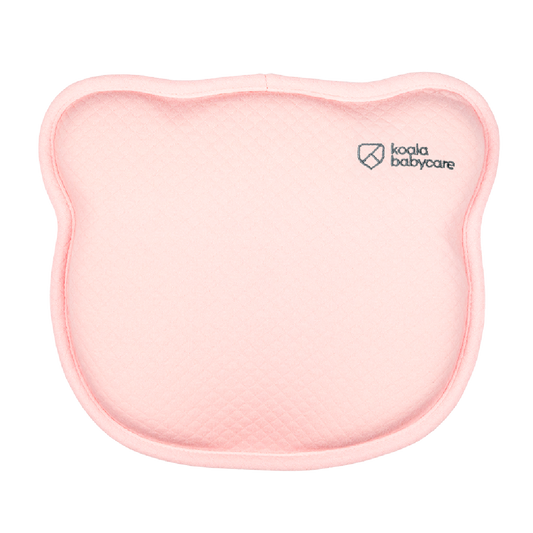Parents know that Tummy Time is very important, however they may struggle a little when it comes to putting theory into practice. What to do if baby cries during Tummy Time? How to fit it into your routine as a working parent? How to teach it to caregivers? Read on and discover all the answers!
Tummy Time helps infants develop strength and motor coordination as well as preventing flat head syndrome. Parents understand that it’s important for their newborn, but, at the same time, may find putting the theory into practice a little challenging.
What to do if baby cries during Tummy Time? How to fit it into your routine as a working parent? How to teach it to caregivers who look after your child several hours a day? Let's try to answer your questions!
Why is it worth both the time and effort? Tummy Time benefits
Young infants practically spend all of their time lying on their backs, which is the main reason why practising a little Tummy Time each day (strictly only when your baby is awake and only under adult supervision) offers many benefits, such as:
- It reduces the risk of Positional Plagiocephaly (commonly known as Flat Head Syndrome) in babies.
- It helps strengthen a baby’s shoulder and neck muscles and improve their head control. This forms the basis for learning to roll, to move around and crawl.
- It promotes sensory development, allowing babies to experience and explore the world around them from a different perspective.
When to start Tummy Time?
Right away is the best age for tummy time! Start by holding your baby on your belly, skin-to-skin. Your face and your voice are a novelty for your newborn and will provide stimulation as they try to look at you.
The earlier you start, the sooner your baby will start to enjoy tummy time positions. If you start too late, they often find it unpleasant, as they are not used to holding such a position and will most likely find it uncomfortable.
When your baby turns two or three months old, you can introduce using tummy time toys, such as: a mirror, a book or objects to attract their attention.
One way to make it easier is to use your trusty Koala Hug Baby breastfeeding pillow as a tummy time pillow, resting your baby's chest and arms on top.
When should I stop doing Tummy Time?
When your baby learns to sit up and crawl, they are able to master Tummy Time. The prone position (i.e., on their stomachs) simply becomes a transitional phase between lying flat and sitting up.
What should I do if my baby cries during Tummy Time?
The same thing you usually do when they cry. Cuddle your baby, give them a break, and then try again when they calm down.
Bear in mind that tummy time is a tiring position for a newborn baby, and it’s only normal that after a few minutes they will have had enough and start to fuss.
It will gradually become easier and more natural for your infant, and they will be able to hold the position for longer periods and more comfortably.
To distract your baby, use toys or a book to arouse their interest.
How long for Tummy Time each day?
The amount of time spent doing Tummy Time is probably more than you thought:
- 15-30 minutes a day at 2 months old
- 30-60 minutes a day at 3 months old
- 60-90 minutes a day at 4 months old
The important thing is that you consistently dedicate at least 15 minutes per day to it. Also consider that the above timing also includes a short break, i.e.: a few minutes of Tummy Time and then rest, Tummy Time and then rest, just as if they were doing a workout at the gym.
How to do Tummy Time with newborn?
Let's not forget that Tummy Time, first and foremost, forms part of playtime, and, therefore, should be enjoyable for your baby.
To make it fun for your infant, first ensure they are clean, fed and rested.
It’s very important that you are able to devote yourself in full to your baby during Tummy Time. This is not the right time to for distractions, looking at your phone or the TV. Your baby must have your full attention, so they can sense your presence, hear your voice. Eye contact is also very important.
The first thing your newborn needs to learn is to strengthen their neck and back muscles and to turn their little head. At the beginning your infant may find it more challenging to turn their head to one particular side: if they struggle to turn their head to that side, then gently help to turn it for them and place it on the floor.
How to stimulate a newborn’s interest in playtime?
Show them a rattle, colourful books, their own reflection in the mirror. The toy should always be close to your baby, to stimulate them to turn their head, and then, at a later stage, to encourage them to grab hold of it and bring it towards their mouth.
A nursing pillow is a great help both for holding the position with less effort and for the development of a baby's muscles.
How do I fit it into my busy day?
Parents, especially once they’re back at work, do nothing but rush back and forth from their child to whatever commitment they have, trying to devote as much time as possible to their child in-between. With such a constant juggle, how do you manage to dedicate half an hour or more to Tummy Time each day?
The secret, as always, is to make it an integral part of your routine. Initially, it may prove difficult, but then it will slowly become an indispensable part of your day and you’ll find it becomes effortless.
If you’re unable to practise any on one particular day, don't worry or stress over it! You’ll do some again the following day. You can also teach your child's carer to do some in your absence by explaining which type of toys or little games your baby likes to play best when lying on their stomach for Tummy Time activity.
A little tip: Tummy Time can also be done away from home, by just holding your baby in your arms or on top of you.
My baby hates Tummy Time: why?
If your infant doesn’t like Tummy Time at all, it may be for one of the following reasons:
- You’ve started Tummy Time too late, resulting in your baby finding it challenging. How to fix this? Persist and introduce it gradually – a little at a time, taking breaks whenever your infant shows signs of it being too much. They’ll improve over time.
- They’re practising Tummy Time too often. Perhaps several times a day, for long intervals at a time.
- Your baby is suffering from Torticollis (a stiff neck). Infants often have a preferred side to turn their head to, the same side they lean towards when lying down. Consequently, they may struggle to turn their head to the other side. Seek advice from your child’s doctor or an osteopath who’ll be able to offer guidance on developing this side of their neck.
- The toys or objects used to stimulate your baby, are failing to attract their attention and motivate them to lift their little head whilst on their stomachs. We recommend that you use Koala Hug Baby pillow to help make it easier and that you play with tummy time toys, a tummy time mirror or a rattle to capture your baby’s attention.
Happy Tummy Time to all you dear mums and dads!










